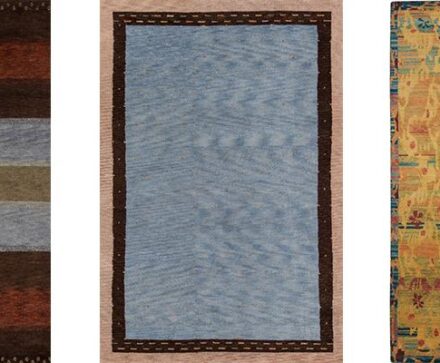What Are the Different Types of Rug Looms?
Creating rugs is an art as old as time. Sam Presnell from The Rug Gallery talks about how rug looms are used to create unique and beautiful designs either by hand or by machine. Listen or read more to find out about the different types of rug looms.
John Maher: Welcome to The Rug Gallery with Sam Presnell. The Rug Gallery is an Oriental rug company and carpet store in Cincinnati, Ohio. I’m John Maher and I’m here with the owner of The Rug Gallery, Sam Presnell. Hi, Sam.
Sam Presnell: Hi, John.
John: Sam, today we’re talking about what are the different types of rug looms? What is a rug loom?
Sam: A rug loom is hard to describe, but I’m sure most people have seen one or have some concept of it. It’s basic — if you can imagine two poles with the strings attached to both sides, kind of in a looping fashion. Those are the strings in which the foundation of the rug is woven upon. You tie the knots upon there. It could be a flat woven rug that could be knotted as well.
Then, between every row of knots or weave, you would put a piece of filler material which basically would hold it together on the sides by going sideways like you would make a rag rug. You would just go up and over each, under each — we call warp threads, which are basically those strings that you strung the poles with and that’s basically what a loom looks like. There’s some different types of looms though which I think most people are not aware of.
There’s a — what we call horizontal or a flat loom. Flat looms are a bit more of a nomadic type from the old days where they were used because a lot of people were nomads. They would wander the grasslands with their sheep, their herds and so they needed something they could stake and then pull up and roll up and then put on the back of the camel or horse and go to the next grazing grounds. Then they would stake it back out and do it again and start weaving.
Another reason why you had looms is because they had wool so they would make things out of that. That’s where the rug weaving actually began, probably — who knows — thousands of years before Christ. You know what I mean? It’s this incredible long history of rug weaving. Sheepherding has been around — who knows how long? It’s been something man has just done. The flat looms are more of what we call tribal.
Today we use the flat looms for the Dhurries or the Kelim. More of the flat weaves type of products we see in those flat looms or horizontal looms. Then, the vertical looms which would be basically you can imagine you’re standing it up and stretching it between two poles. Those are usually a little finer end, finer knotted rugs. Not always but as a whole. We used to see that in a shed or in a building or something like that where there’d be some covering on it.
Loom and Weaving Technique
John: Do different types of looms make different types of rugs?
Sam: Yes. Like I said, the different types of looms you’d have a flat woven. You could definitely do that. You could do a combination of basically flat and a pile with it. You can do all piled with it. There’s different things you can do with looms but basically, it’s more about the technique of knotting and weaving that makes a difference in the rugs, not so much the looms.
John: Okay. How does the type of loom affect the end result of a rug?
Sam: Well, I don’t know that it really affects it a whole lot. It really depends upon the knotting, again the quality of the weaver, the quality of the wool, the artistic ability of that person to blend the colors. Those things I think play more of an important part in how a rug looks. The loom is not that important as far as the look of the rug.
Machine Loom vs. Hand Loom
John: When we think now of a more modern and machine-made rug, is that still done on a loom but just controlled by a machine or how does that work?
Sam: Well, it’s similar in lots of different ways except it’s totally different in how it’s done as far as machinery is totally different and that’s very mechanical. It’s inserting a pile-up, there’s another thing that grabs the — as it gets inserted up that grabs it and carries it up or drops it back down and carries it around the back. It’s like weaving but using a sewing machine type of a concept when you see the looms that are — we call them Wilton looms or Axminster looms which most rugs are made on today.
It’s pretty high speed and pretty amazing the amount of things we’re able to do today with the help of computers that make these looms very talented and quick.
Differences Between Machine and Hand-knotted Rugs
John: You end up with a different kind of style or a different type of rug that you can tell the difference between that and a hand-knotted rug.
Sam: You can because what happens, this is not always and [not] every rug is this a hundred percent, but when you look at the back of a machine-made rug, it always looks the same throughout the entire rug. In a hand-knot rug, you’ll see those lines will change. You’ll see variations, you’ll see design changes. A lot of times when a new rug’s on machine looms, they’ll try to build those into it.
It’s very obvious from the back that it’s a machine done instead of handmade. Also, when you see what’s holding the rug together, on a handmade rug, it’s the weft or the — we call it the east of west — going sideways or horizontal with the filler yarn that holds that rug together sideways. On a machine-made rug, it’s actually woven upon the wefts and then held together by the warps or the north and south or vertical lines.
John: All right. That’s really great information, Sam. Thanks again for speaking with me today.
Sam: All right, John. You’re very welcome.John: For more information about Sam, The Rug Gallery and oriental rugs and carpets, visit RugGalleryCincy.com. That’s ruggallery C-I-N-C-Y.com or call 513-793-9505. Make sure you catch the latest episodes by subscribing to this podcast on iTunes. If you can take the time to give us a review as well, we’d appreciate that. I’m John Maher. See you next time on The Rug Gallery.

